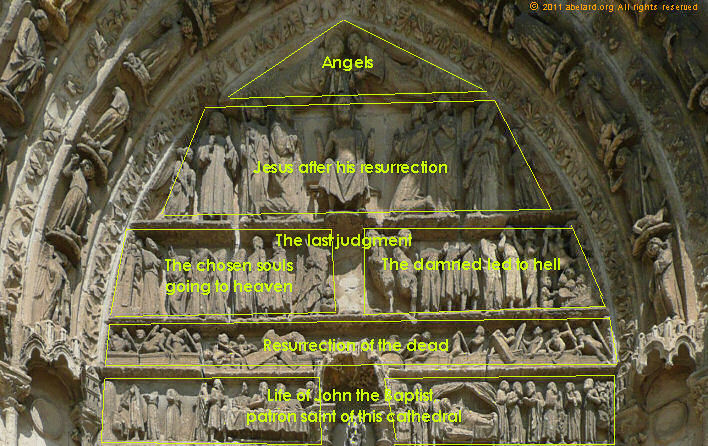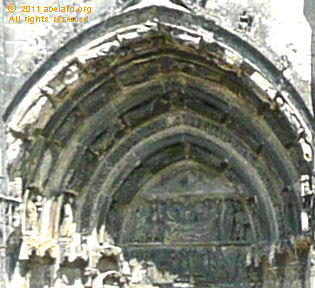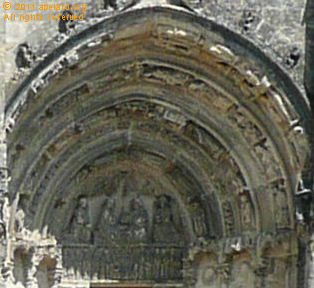france
new! Cathedrale Saint-Gatien at Tours 
 updated: Romanesque churches and cathedrals in south-west France updated: Romanesque churches and cathedrals in south-west France
the perpendicular or English style of cathedral 
the fire at the cathedral of Notre-Dame de Paris

cathedral giants - Amiens and Beauvais
Stone tracery in church and
cathedral construction 
stone in church and cathedral construction stained glass and cathedrals in Normandy  
fortified churches, mostly in Les Landes
cathedral labyrinths and mazes in France
using metal in gothic cathedral construction
Germans in France
cathedral destruction during the French revolution, subsidiary page to Germans in France

on first arriving in France - driving
France is not England
paying at the péage (toll station)

Transbordeur bridges in France and the world 2: focus on Portugalete, Chicago,
Rochefort-Martrou
Gustave Eiffel’s first work: the Eiffel passerelle, Bordeaux
a fifth bridge coming to Bordeaux: pont Chaban-Delmas, a new vertical lift bridge
France’s western isles: Ile de Ré
France’s western iles: Ile d’Oleron
Ile de France, Paris: in the context of Abelard and of French cathedrals
short biography of Pierre (Peter) Abelard
Marianne - a French national symbol, with French definitive stamps
la Belle Epoque
Grand Palais, Paris


Pic du Midi - observing stars clearly, A64
Carcassonne, A61: world heritage fortified city
Futuroscope
Vulcania
Space City, Toulouse
the French umbrella & Aurillac
50 years old:
Citroën DS
the Citroën 2CV:
a French motoring icon
the forest as seen by Francois Mauriac, and today
Les Landes, places and playtime
roundabout art of Les Landes
Hermès scarves

bastide towns
mardi gras! carnival in Basque country
country life in France: the poultry fair
what a hair cut! m & french pop/rock

Le Tour de France: cycling tactics 


|
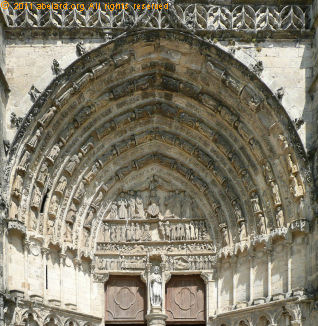
Bazas cathedral, west portal
Frequently, the sculptures illustrating
the Last Judgment are incorporated in the west portal,
which faces the setting sun, so to recall the last Judgment
at the end of time on Earth.
the
dog’s dinner

Bazas cathedral, west facade
As you can see, the west front of Bazas cathedral is
a three-tiered dog’s dinner, with a Renaissance/Baroque
upper structure stuck on top of the rose window from 1537,
heaped on the 13th century gothic cathedral at the bottom.
I am not very keen on some of this architectural jargon,
Renaissance [rebirth] architecture is usually regarded
as harking back to Greek and Roman styles, perhaps a reincarnation,
rather than a rebirth. The more fussy and complicated
a Renaissance building becomes, the more likely the use
of the word Baroque.
Remember, my interest in this series of pages is centred
around gothic cathedrals, with less interest in the precursor
Romanesque style, or the later Renaissance/Baroque changes.
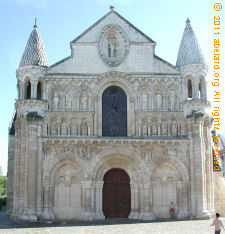 |
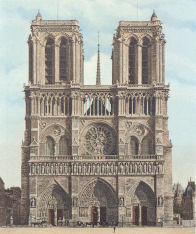 |
| Romanesque church
(Église de Notre-Dame la Grande, Poitiers) |
Gothic
cathedral (Notre-Dame, Paris) |
|
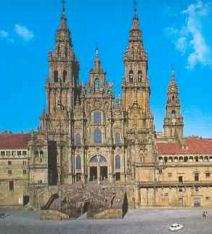 |
| Renaissance
cathedral, Arras |
Baroque cathedral,
(Santiago de Compostela, NW Spain) |
the
cathedral’s main features
The main features of interest at Bazas are
- the west front/facade - a general
view is near the head of this page
- the rayonnant west rose (below)

West rose, Bazas cathedral - interior
view
the names of the first sixty-four bishops
of Bazas, and their years of office,
are written on the the petals.
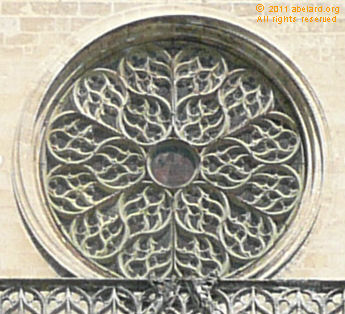
West rose, Bazas cathedral - exterior
view
For
more on the stained glass at Bazas cathedral.
The west front dates from the 13th, 16th and 18th centuries,
the sculptures from the 13th century.
“For being filled with statues, after the northern
plan, these doors excited the special fury of the Huguenots
who were inspired by the verse of their new Bible-lore,
"Thou shalt not make unto thee any graven image."
Perhaps in the destruction of the multitudes of statues
their fervour was satiated, perhaps they were interrupted,
for they spared the tympanum of each door, and we have
here, although much worn and broken by time, the Resurrection
and the Judgment of the Dead, appropriate scenes from
the life of the patron Saint, carvings of the Virgin's
life, and Bible stories; and on the pier which divides
the central doorway, Saint-John still stands.” [2]
And the real reason was in 1561, local inhabitants saved
13th century sculptures from the Huguenots (Protestants)
by paying a ransom of 10,000 écus.
“At
Bazas, the builders have used the graceful flying
buttress of the north with much more skill and freedom
than we find at Lectoure. But with less caution appeared
a too jocular, a too gasconnading temerity; and two
buttresses, airily ornamented, not only fulfill their
normal function, but support a piece of the front
wall which would otherwise rise detached and meaningless,
unless, in turn, it were built to support the central
rose. Above this window again,
rises a bit of construction which deserves only to
be torn down, as it forms no component part of the
whole.[3] It is so obviously
of that irresponsible architectural age, the XVII
century, that the careful men who succeeded to the
task of finishing this large church, must be absolved
from this, its crowning defect. [2]
 
“The sides of the Cathedral are ornamented
with a double row of gargoyles; and here the modification
of the northern style — the acclimation of the
animal, as it were, is delightful. For at Paris, at
Chartres, or where you will in the Isle de France,
the gargoyle is comfort ably perched in his devilish
malignity. Here he is truly Gascon, stretching so
far beyond the church wall that his claws clutch the
stone desperately, leaning far over the street as
if ready for the spring, grinning in a significant,
personal way, which, for all he is of stone, is quite
terrifying.” [2]
 To
the south side of cathedral, there is a little garden
with seats and a view of the precipitous drop, an archeological
dig with commentary, and some views of the external
cathedral structure, such as the flying buttresses and
the gargoyles. To
the south side of cathedral, there is a little garden
with seats and a view of the precipitous drop, an archeological
dig with commentary, and some views of the external
cathedral structure, such as the flying buttresses and
the gargoyles.
|
advertising disclaimer
|

|
This is the tympanum of the central, main door. The
carvings have been much degraded by centuries of attack
from the elements.
Here are two details from the Last Judgment row:
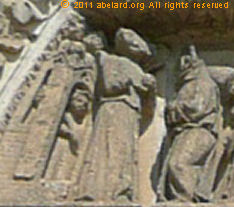 |
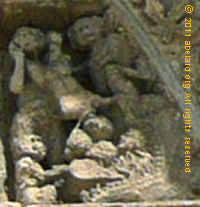 |
On the right a chosen soul (whose
head is now gone) being greeted by an angel. To
the left is the heavens door, as small as the eye
of a needle, symbolising the difficulty in entering
heaven. In the doorway is a chosen soul.
[Mt 19-24, Mk 10-25, Lk 13-24] |
To the bottom right is the head of
the Leviathan, its gaping, fiery jaws bristling
with teeth ready to eat damned souls. A demon uses
bellows to encourage the flames. On the left, another
demon holds a damned soul by the heels to feed him
to the Leviathan.
They certainly had a taste for the blood-thirsty,
but then they had no cops and robbers on TV. |
The tympanum of the right door (as
you exit the cathedral) depicts scenes from the
life of Saint Peter, while that of the left door shows
events in the life of Mary. |
|
For more
information on the components of a west portail.
Floor plan of the cathedral

some
background history and information
- Bazas cathedral started 1233.
- The cathedral is dedicated to Saint-Jean-Baptiste.
- Cathedral restored between 1583 and
1635, after religious wars (1578-1605).
- Classed as a historic monument in 1840.
- 1998 Added to the list of UNESCO world heritage sites,
as part of the Chemin de Compostela.
- West facade altered in 15-16th century, and the 18th
century.
- Cathedral coordinates : N44 25 53.4 E0 12 40.7
- The town is ramparted, of which some still exists.
- The economy of Bazas is based on Bazadais cattle,
wood industry, metal industry.
- The nearest motorway is the A65,
opened in 2011, which has an exit/sortie at Bazas.
| Background
facts |
Bazas 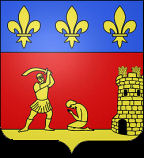 |
- approximate population : 4,500
average altitude/elevation : 55 m
- (ranging from 34 m to 123 m)
-
-
- cathedral dimensions
- nave length : 80 m
height under vaults : 20 m
|
end
notes
- The name Bazas comes
from the Latin civitas basatica, City of the
Vasates. The town’s historic name was Cossium,
a latinisation of the Aquitanian word koiz,
or the Gascon word coç, which mean‘burial
mound’.
The inhabitants are called Bazadais.
- Cathedrals and
cloisters of midland France by Elise Whitlock
Rose, 1907
- However, recent Michelin
tourist guides have it that, “The west front is
of an attractive and cohesive design, despite the difference
in style of the three stories.” Me, I’m
fully in accord with Elise Rose. In those days, at the
beginning of the 20th century, people were far more
inclined to use their eyes and to tell it as it is,
rather than saying vapid things for the tourists. You
can better trust those who give it to you straight.
I also would like to see the Renaissance top demolished.
- 10,000 écus in
1575 was probably worth in the region of $450,000, or
about 340,000 € [as at July 2011; calculated using
silver at $36/oz, $1.45 to 1€, écu value
defined in Henry III ordinance, 31 May 1575, data based
on multicollec.net].
- The word tympana is the plural of tympanum. Tympanum is a Latin word, and those that end in -um, second declension
neuter, decline to -a in the plural.
Many will remember declining bellum, war:
Bellum, bellum, bellum, belli, bello, bello
Bella, bella, bella, bellorum, bellis, bellis.
Of course, this degenerated in schoolboy/girl fashion
to
B’lum, b’lum, b’lum, b’li, b’lo,
b’lo
B’la, b’la, b’la, b’lorum, b’lis,
b’lis!
- In all there have
been sixty-five bishops of Bazas. The first bishop,
Pierre, was appointed in 453, while the last, Jean-Baptiste-Amédée
de Gregoire de Saint-Saveur, was bishop from 1746 to
1790.
In the early twentieth century, Monsigneur Maurice Felton,
Archbishop of Bordeaux, had requested a decree through
the Holy Constitutional Congregation. This decree was
given, at Rome on 20 November 1937, by Pope
Pius XI, declaring that the Archbishop of Bordeaux
would also have the title of Bishop of Bazas.
|
























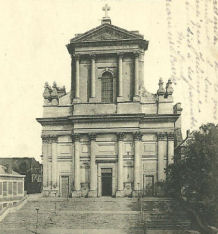





 To
the south side of cathedral, there is a little garden
with seats and a view of the precipitous drop, an archeological
dig with commentary, and some views of the external
cathedral structure, such as the flying buttresses and
the gargoyles.
To
the south side of cathedral, there is a little garden
with seats and a view of the precipitous drop, an archeological
dig with commentary, and some views of the external
cathedral structure, such as the flying buttresses and
the gargoyles. 